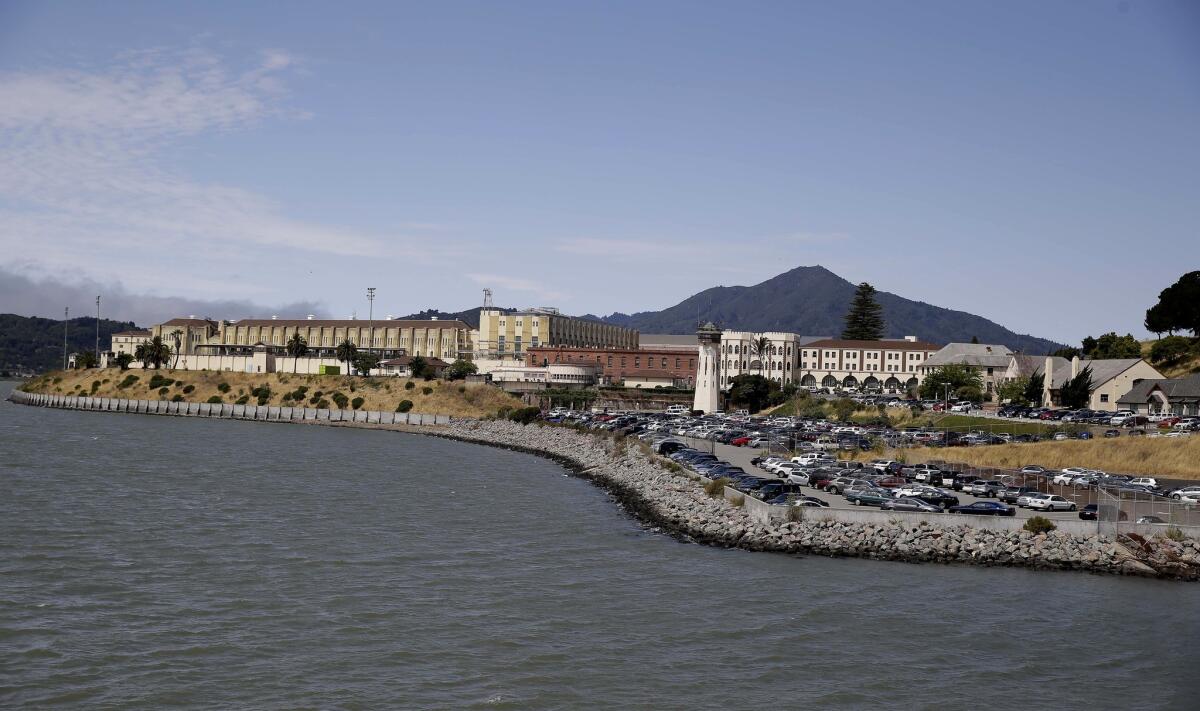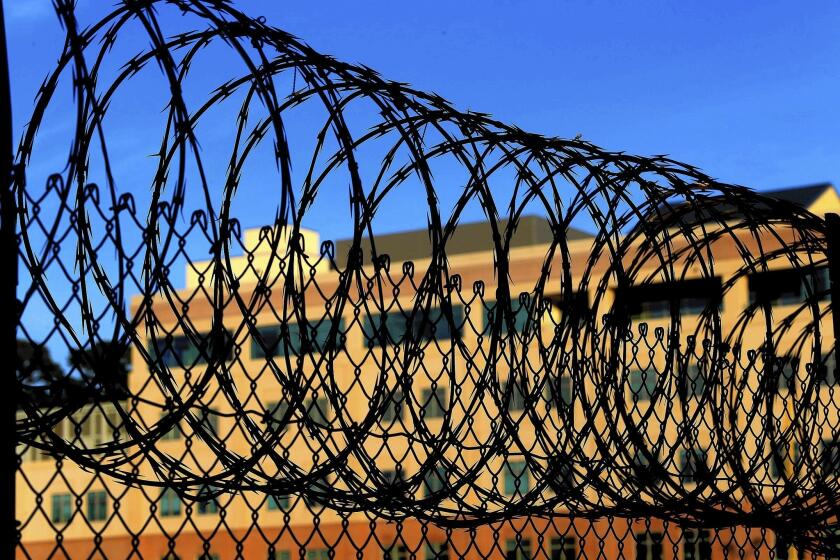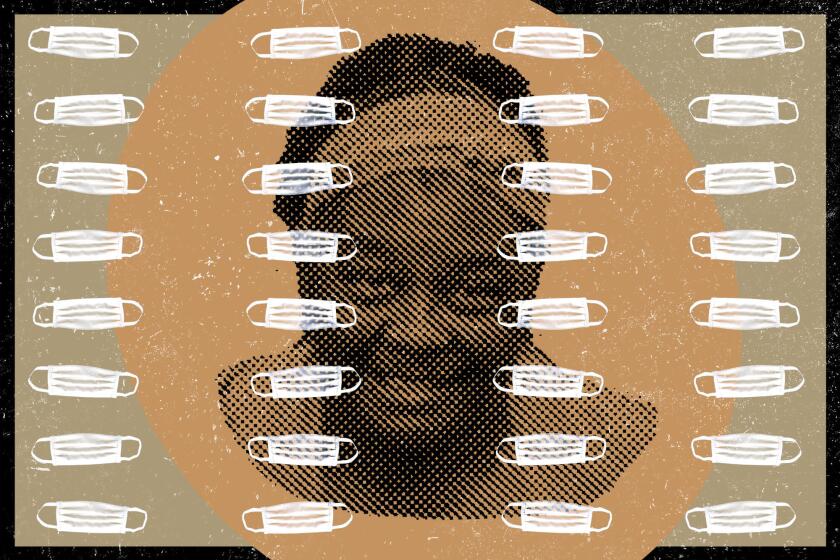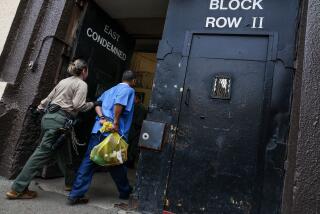Court orders San Quentin prison to sharply cut inmate population after COVID outbreak

- Share via
California corrections officials must release or transfer more than 1,000 inmates from the state’s notoriously outdated San Quentin prison after showing “deliberate indifference” to prisoners’ health during an outbreak of the novel coronavirus, an appeals court ruled this week.
Under the decision issued late Tuesday by a three-judge panel from the 1st District Court of Appeal, the Bay Area facility can house “no more than 1,775 inmates” — half of what the prison’s population was in June and a drop of more than a third from the roughly 2,900 people currently housed there.
The ruling comes in a case filed by an inmate in May that challenged the prison’s ability to prevent an outbreak of the virus. Within a few weeks, the number of infections among prisoners had begun to soar as the virus spread unchecked through the state’s oldest prison, infecting more than 2,200 prisoners and killing at least 28. .
“By all accounts, the COVID-19 outbreak at San Quentin has been the worst epidemiological disaster in California’s correctional history. And there is no assurance San Quentin will not experience a second or even third spike,” Presiding Justice J. Anthony Kline wrote in the opinion. “Failure to immediately adopt and implement measures designed to eliminate double celling, dormitory-style housing and other measures to permit physical distancing between inmates is morally indefensible and constitutionally untenable.”
The court found that, despite being aware that many San Quentin inmates were particularly vulnerable to the virus because of their age or underlying health conditions, officials from the California Department of Corrections and Rehabilitation failed to adequately reduce the prison’s population by transferring or granting early parole to a large number of inmates. The court noted that a panel of physicians recommended the population be halved after visiting the prison.
The death brings the total to 13 among prisoners at the Marin County facility.
The inmate who filed the case, Ivan Von Staich, is serving a life sentence for killing the husband of his ex-girlfriend. Von Staich’s lawyers, saying he had a lung condition that made him vulnerable to contracting COVID-19, the sometimes deadly illness caused by the virus, argued that the prison conditions amounted to cruel and unusual punishment under the Constitution because it was impossible for inmates to maintain safe distances from one another and observe other safeguards.
The appeals court ordered that Von Staich be released or transferred to another prison. A parole board last week recommended he be released on parole, although Gov. Gavin Newsom could veto the recommendation.
In addition, the judges ruled that prison officials must provide sufficient social distancing for all the inmates in San Quentin. To do so, they found, the number of people housed in the facility had to be cut through transfers to other facilities or releases.
In response to the ruling, the corrections department released a statement Wednesday saying it was in the process of determining how to accomplish the ordered reduction. The department could appeal the decision to the state Supreme Court and ask it for a restraining order to put the inmate reduction on hold.
“We respectfully disagree with the court’s determination, as CDCR has taken extensive actions to respond to the COVID-19 pandemic,” the statement said. “Since March, the department has released more than 21,000 persons, resulting in the lowest prison population in decades.”
Since March 12, California’s overall prison population has declined by 22,629 inmates and as of Tuesday stood at 92,414, according to corrections department statistics.
Corrections officials argued the toll the coronavirus is now taking in state prisons has declined dramatically, with 474 new cases reported across the whole system on Tuesday and only one inmate at San Quentin testing positive over the past month. In all, more than 14,000 inmates have contracted the illness.
But the appeals court noted that California’s deadliest outbreak in a prison began in June when 121 inmates were transferred to San Quentin from another prison that was experiencing a surge of cases. That facility, the California Institution for Men in Chino, selected 700 inmates for transfer but failed to adequately test them before they left and some carried the virus to other prisons around the state.
Inmates who went through that experienced described the terror and helplessness they felt as the virus raged and, one by one, fellow prisoners got sick and in some cases died.
In making their ruling, the judges singled out San Quentin from the state’s other 24 prisons, finding its age and antiquated design made it a particularly dangerous place to be locked up during the pandemic. The ruling did not specify how San Quentin must go about reducing its population.
Inmates who made masks and furniture for as little as 35 cents an hour say they felt pressure to stay on the job, even as the coronavirus spread through the prison factories.
At a prison with “exceedingly poor ventilation, extraordinarily close living quarters, and inadequate sanitation ... the continued use of double cells and congregate living spaces is not merely negligent, it is reckless,” the court wrote.
The panel advised that the corrections department consider expediting the release of inmates over 60, who have served 25 years of their sentences and are eligible for parole.
More to Read
Sign up for Essential California
The most important California stories and recommendations in your inbox every morning.
You may occasionally receive promotional content from the Los Angeles Times.













